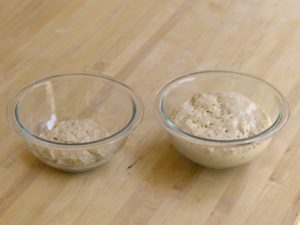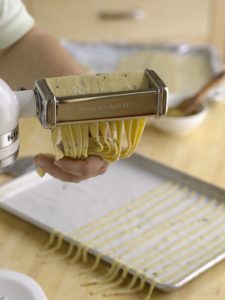Whether it is wheat, rye, or gluten-free, bread is a staple food for most of us. We eat it at breakfast as toast, for lunch as peanut butter sandwiches, and with dinner to dip into our favorite soup.
And like all things, bread that you make with your own hands is tastier, just from knowing that youdid that.
For a lot of people, making bread is scary, because, after all, bread is alive, and it feels like there are so many mistakes to make. But yeast should not be the ingredient that makes you turn the page in a cookbook, because it is NOT an indicator that a recipe is hard. Pinky swear—you can make bread!
If you aren’t sure about taking the plunge in the world of bread baking, how about a simple bread recipe that skips most of the scary stuff?
Friends, meet Grissini. You may have never heard this word before, but grissini are basically just long, skinny Italian-style breadsticks. They’re great for snacking, dipping into salted butter or hummus, or served alongside a cheese plate for a crunchy bite. The version we love best has some herbs and a little bit of cheese mixed in, but you can make yours as plain or elaborate as you want.
You start by making a yeast dough that will have to rise, but that’s no harder than mixing cookie dough or cake batter. The rising processis the time we give the dough to go through the process of fermentation. Fermentation happens when the yeast eats the carbohydrates in the dough (ones that we add, like sugar, or ones that are naturally occurring in the flour) to create carbon dioxide and organic alcohols.
Carbon dioxide is the same air that we breathe out of our mouths when we exhale. So just like we can use it to fill up a balloon, it becomes trapped in the dough, which you can see with air bubbles and a balloon-like feeling when you touch it. When a recipe says to rest a dough until it “doubles in size,” it is being inflated, just like a balloon, by new carbon dioxide.

The organic alcohols are what makes bread a little tangy or sour. Some bread has more sour flavor, which is a result of longer fermentation, but some breads are really mild, like white bread or the grissini you’ll be making.
As long as the circumstances are right, you don’t have to do anything to create fermentation. The right conditions are:
- Proper temperature. Yeast likes when it’s warm. If it gets too hot, the yeast will die. If it’s too cold, the yeast will basically no into nap mode until it warms up again. This is why we can leave bread dough in the refrigerator overnight if we aren’t ready to bake it. It takes a snooze. If a recipe calls for warm water to mix with your yeast, you want it to feel warmer than your own hand, but it shouldn’t be too hot to touch for 5 seconds.
- Availability of carbohydrates to eat. Yeast gets hungry, so we need to be sure it has plenty of food to eat. Recipes will often call to “fold” the dough after it’s been resting for a little while. We do this to help move the yeast to new sources of food, so it doesn’t get hangry.
- Age of the yeast. Since yeast can be alive, we have to assume it can also be.. well, not alive. If you don’t make bread a lot, you can have yeast in your fridge for a long time, and eventually, it will be too old to use. To check that your yeast is still active, sprinkle it into a bowl of warm (not hot!) water. If after about 5 minutes, it’s a little fizzy and bubbly, you’re good to go.
Back to the grissini. You’re going to make your dough and let it ferment. Eventually, you shape it, which is the easiest part of grissini. In our recipe, we suggest putting it through a pasta maker, which cuts thing strips of dough. But you can also roll it out with a rolling pin and cut it with a pizza cutter into thin strips. You can break off small pieces (about the size of a golf ball) and then use the palms of your hands to roll it into pencil-thin pieces.

Once you’ve mastered grissini, take a look at other flatbread recipes, like pizza and pitas. They’re just as simple and forgiving. You’ve got this!

Where are the amounts of the ingredients?
HI there! You can find the full Grissini recipe here: https://www.ciafoodies.com/grissini/